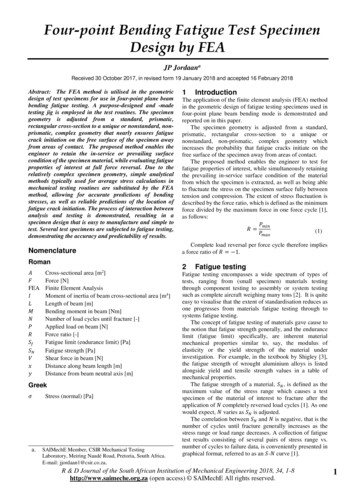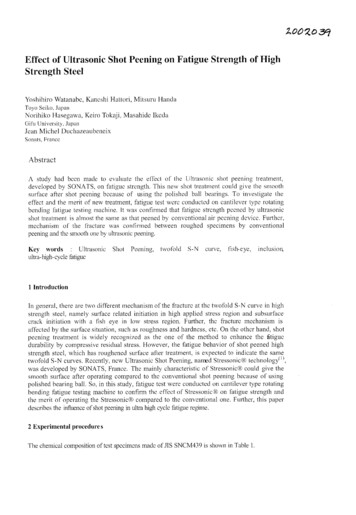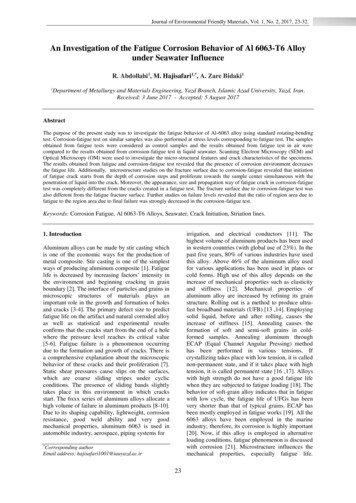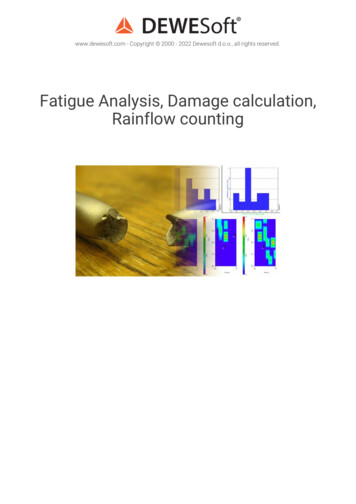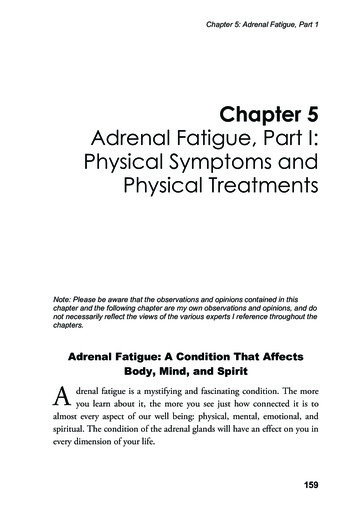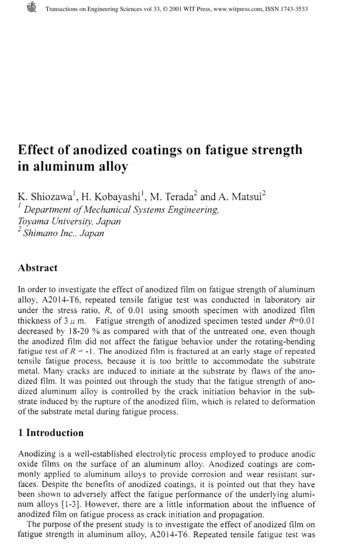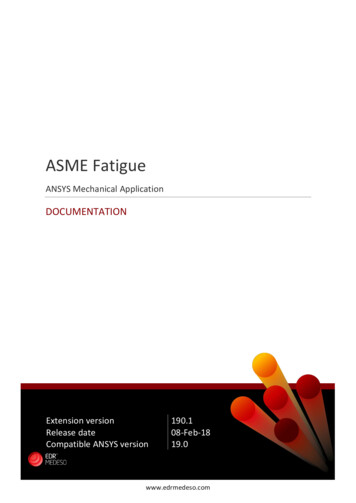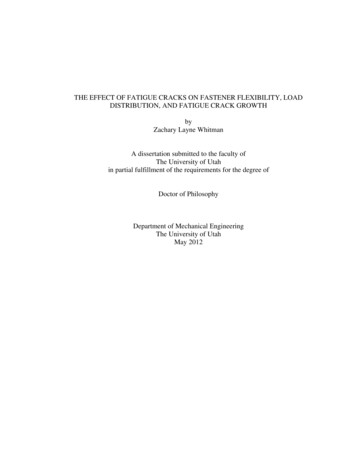
Transcription
THE EFFECT OF FATIGUE CRACKS ON FASTENER FLEXIBILITY, LOADDISTRIBUTION, AND FATIGUE CRACK GROWTHbyZachary Layne WhitmanA dissertation submitted to the faculty ofThe University of Utahin partial fulfillment of the requirements for the degree ofDoctor of PhilosophyDepartment of Mechanical EngineeringThe University of UtahMay 2012
Report Documentation PageForm ApprovedOMB No. 0704-0188Public reporting burden for the collection of information is estimated to average 1 hour per response, including the time for reviewing instructions, searching existing data sources, gathering andmaintaining the data needed, and completing and reviewing the collection of information. Send comments regarding this burden estimate or any other aspect of this collection of information,including suggestions for reducing this burden, to Washington Headquarters Services, Directorate for Information Operations and Reports, 1215 Jefferson Davis Highway, Suite 1204, ArlingtonVA 22202-4302. Respondents should be aware that notwithstanding any other provision of law, no person shall be subject to a penalty for failing to comply with a collection of information if itdoes not display a currently valid OMB control number.1. REPORT DATE2. REPORT TYPE01 DEC 2011N/A3. DATES COVERED-4. TITLE AND SUBTITLE5a. CONTRACT NUMBERThe Effect of Fatigue Cracks on Fastener Flexibility Load Distributionand Fatigue Crack Growth5b. GRANT NUMBER5c. PROGRAM ELEMENT NUMBER6. AUTHOR(S)5d. PROJECT NUMBERZachary Layne Whitman5e. TASK NUMBER5f. WORK UNIT NUMBER7. PERFORMING ORGANIZATION NAME(S) AND ADDRESS(ES)Department of Mechanical Engineering, University of Utah A-10 SystemsProgram Office Hill AFB Utah9. SPONSORING/MONITORING AGENCY NAME(S) AND ADDRESS(ES)8. PERFORMING ORGANIZATIONREPORT NUMBER10. SPONSOR/MONITOR’S ACRONYM(S)11. SPONSOR/MONITOR’S REPORTNUMBER(S)12. DISTRIBUTION/AVAILABILITY STATEMENTApproved for public release, distribution unlimited13. SUPPLEMENTARY NOTESThe original document contains color images.14. ABSTRACT15. SUBJECT TERMS16. SECURITY CLASSIFICATION OF:17. LIMITATION OFABSTRACTa. REPORTb. ABSTRACTc. THIS PAGEunclassifiedunclassifiedunclassified18. NUMBEROF PAGES19a. NAME OFRESPONSIBLE PERSONUUStandard Form 298 (Rev. 8-98)Prescribed by ANSI Std Z39-18
Copyright Zachary Layne Whitman 2012All Rights Reserved
ABSTRACTFatigue cracks typically occur at stress risers such as geometry changes and holes. Thistype of failure has serious safety and economic repercussions affecting structures such asaircraft.The need to prevent catastrophic failure due to fatigue cracks and otherdiscontinuities has led to durability and damage tolerant methodologies influencing thedesign of aircraft structures.Holes in a plate or sheet filled with a fastener are common fatigue critical locations inaircraft structure requiring damage tolerance analysis (DTA). Often, the fastener istransferring load which leads to a loading condition involving both far-field stresses suchas tension and bending, and localized bearing at the hole. The difference between thebearing stress and the tensile field at the hole is known as load transfer. The ratio of loadtransfer as well as the magnitude of the stresses plays a significant part in how quickly acrack will progress to failure.Unfortunately, the determination of load transfer in a complex joint is far from trivial.Many methods exist in the open literature regarding the analysis of splices, doublers andattachment joints to determine individual fastener loads. These methods work well forstatic analyses but greater refinement is needed for crack growth analysis. The firstfastener in a splice or joint is typically the most critical but different fastener flexibilityequations will all give different results. The constraint of the fastener head and shop end,along with the type of fastener, affects the stiffness or flexibility of the fastener. This inturn will determine the load that the fastener will transfer within a given fastener pattern.
ivHowever, current methods do not account for the change in flexibility at a fastener as thecrack develops. It is put forth that a crack does indeed reduce the stiffness of a fastenerby changing its constraint, thus lessening the load transfer. A crack growth analysisutilizing reduced load transfer will result in a slower growing crack verses an analysisthat ignores the effect.iv
vACKNOWLEDGEMENTSI would like to thank my beautiful wife Kandace for her support while I pursued thiswork. She is a blessing to our family. Our precious daughters Lily and Briar alsodeserve great thanks for their patience during this endeavor. My hope is that they toogrow up to appreciate the value in dedicating themselves to continual learning. Thisdissertation is devoted to them.My appreciation is extended to members of my committee; whom without their advicethis work would not have been completed.Many of my friends, co-workers, andextended family provided the emotional encouragement to complete my research.Thanks to Southwest Research Institute and many of the staff there for tuition supportand encouragement during my studies, and for conducting the specimen manufacturingand testing. Finally, I would like to thank my Lord and Savior Jesus Christ for the clarityand peace required to complete everything good that I have ever accomplished in my life.To him goes all glory.v
viTABLE OF CONTENTSPageACKNOWLEDGEMENTS . v1.0 INTRODUCTION. 1-11.1Aircraft in the Early Years . 1-21.2Fatigue the Early Years . 1-71.3Aircraft and Fatigue . 1-111.4Dissertation Hypothesis and Constraints. 1-242.0 TYPES OF FASTENERS. 2-13.0 TYPES OF JOINTS . 3-13.1Joint Configurations and Fastener Patterns . 3-14.0 JOINT LOAD ANALYSIS . 4-14.1Wooden Joints . 4-54.2Fastener Flexibility . 4-74.3Fastener Flexibility Equations . 4-94.4Solution Methods Using Fastener Flexibility . 4-174.5Finite Element Modeling of Fasteners . 4-205.0 JOINT ANALYSIS METHODS. 5-15.1Material Data . 5-15.2Static Strength Methods . 5-25.3Durability Methods . 5-105.4Damage Tolerance Analysis Methods . 5-136.0 T-38 F.S. 284 SPLICE JOINT . 6-16.1F.S. 284 Splice Joint Mechanical Testing. 6-16.2F.S. 284 Splice Joint Finite Element Modeling and Load Analysis . 6-156.2.1 Modeling Results. 6-206.2.2 Finite Element Model Verification and Validation . 6-236.3F.S. 284 Splice Joint Stress Intensity and Crack Growth Analysis . 6-256.4Comparison of Different Load Analysis Methods . 6-366.4.1 The Static Strength Load Distribution Method . 6-376.4.2 Fastener Flexibility Load Distribution Methods . 6-386.4.3 Finite Element Load Distribution Methods . 6-446.5Comparison of Different Damage Tolerance Analysis Methods . 6-496.5.1 Classical Solutions for Damage Tolerance Analysis . 6-506.5.2 Comparison of Joint Specimens with Built-In AFGROW Models . 6-687.0 CONCLUSIONS . 7-18.0 RECOMMENDATIONS . 8-19.0 REFERENCES. 9-1vi
1.0INTRODUCTIONThe central focus of this dissertation is the study of joint analysis methods, specificallyaircraft and how cracks affect the underlying analytical assumptions.Within thispotentially broad spectrum there will be a focus on multiple fastener joints which transferload via fasteners and the different layers they join. The coming sub-sections discussfatigue in general and different paradigms used in aircraft over the years. The chapterfollowing discusses fasteners, specifically those looked at in this dissertation. Chapter3.0 contains discussion on the types of joints considered while Chapter 4.2 discussesfastener flexibility. These two chapters are critical since the type of joint affects thefastener flexibility and the fastener flexibility affects the amount of load transferred byeach fastener. The more load transferred by a fastener, the more severe the crack growth.These methods all serve well for ‘pristine’ structure as designed, devoid of cracks orother discontinuities. However, once cracks start to form, the assumptions of theseanalysis methods can lose validity leading to less accuracy and precision than may berequired. No prior method attempts to define load transfer for fasteners considering thepresence of a crack and how it in turn affects the growth of the crack. Thus, as the effectof the crack starts to impact the load transfer of the joint there is a need to account for itspresence to retain the accuracy of the analysis.
1-2The study of these types of joints is not a new art. Civil engineers have used differentmethods to analyze the loads in fasteners for well over a hundred years as steel beamconstruction came into vogue. Similar considerations were made by the pioneers ofaviation when analyzing the strength of details on aircraft. This early work involvedmainly steels and non-isotropic materials; e.g. wood being bolted and glued together. Inthe most early of aircraft, fatigue was not a major design or operational consideration.More recently, fatigue became much more influential in the design and in the operationof aircraft. Thus the introduction splits the early background of the two topics separately,combining them as fatigue becomes a major factor considered in aviation. To avoid theneed to bounce back and forth, Section 1.1 focuses on the background of joint analysisspecifically as it relates to this topic in aircraft. Section 1.1 ends right about the time thatfatigue starts to become part of the aviation world and breaks to Section 1.2 whichdiscusses the evolution of the study of fatigue. Section 1.3 then picks up right about thetime that fatigue becomes a crucial part of aviation.While the order is non-chronological, it should help keep the reader focused on each topic until their paths cross.1.1Aircraft in the Early YearsAluminum in aircraft structures was relatively uncommon if not completely unheard of inthe early 20th century. Wood was the primary structural material usually as compressionand bending members with steel cables bracing the structure as tension members [1, 2].Aircraft design tasks such as weight estimation were simplified by the commonality ofmany of the different wood/wire structures made during the period [3]. The benefit of1-2
1-3wood over contemporary metal alloys was its strength to weight ratio [4]. In addition,wood has the capability to survive stresses above the normal design strength for shortperiods of time so the structures ability to survive abrupt overloads during gusts andlandings likely saved the life of many an early aviator [5].In the seminal 1919 book on aircraft structural analysis, Pippard and Pritchard [6] wrotethat, “ the aeroplane designer is practically dependent upon two of these, timber andsteel, and even with these his choice is limited to very few varieties.” The lack ofaluminum in allied aircraft structures was reflected by Pomilio who stated that the onlytwo uses for it are fuel tanks and engine cowls [7] which was a sentiment reflected inother contemporary writings as well [8-10]. Andrews and Benson discuss the four mainmaterials of design in their 1920 book as being, timber, duralumin, steel and fabric [11].However, the reign of wood as the principal material for aircraft construction was quicklycoming to an end. As Judge wrote in 1921 [12]:“The modern tendency in aeronautical practice is toward the eliminationof such materials as wood, as the strength of this material depends uponits previous history and subsequent treatment, and is always an unreliablefactor. For this purpose steel, and other metals, is replacing these nonhomogeneous materials, and successful all-metal wings (and indeedcomplete machines have been built.”This sentiment is echoed in many other contemporary writings. [13, 14] Exacerbating thevariation in wood quality was the depletion of many forests of their prime timber.1-3
1-4Economic factors as well as engineering design led to a decline in wood as for structuralmembers for aircraft [15, 16].Metal as a primary structural material and covering was pioneered by Dr. Hugo Junkerswho developed the first all metal monoplane, the J 1 [17]. Its first flight occurred on 12December 1915. The Junkers F 13, first flown on 25 June 1919, was the first all metalcommercial aircraft featuring a single low wing with internal wing bracing and full with ametal covering of corrugated duralumin.It was a development of the similarlyconstructed CL 1 aircraft which was a two seat ground-attack aircraft of WWI. This,when the common aeronautical structure was a wing with wooden spars and ribs, fabriccovering and external bracing using struts and cables. However, butt joints with spliceplates and fasteners is not peculiar to metals alone; considerable research in these types ofjoints were done using plywood as well [18, 19]. In fact, many common metal aircraftdetails were common in wooden structure long before metal aircraft were flying.Metal was increasingly used in aircraft structure during the 1920s though typically in theform of steel tubing and steel strip but fastened joints were still not common in thesestructures since the steel was easily welded. Aircraft were commonly built in this timeperiod with steel tube truss structure with fabric covering [20]. Steel strip structure waswell developed in Britain at Boulton and Paul, Vickers, as well as others manufacturersbut often the design was such that it was merely steel shapes substituting wood in sparand rib designs over 20 years old [21-25]. Aluminum alloys of the early 1920s were stillrather weak and were not used commonly outside of cast engine parts, propellers andother non-structural applications [26]. The one exception is in the wing structure where1-4
1-5the smaller depth due to the airfoil and necessary moment of inertia due to a lack ofexternal bracing meant an increase in the use of metal, particularly aluminums [27, 28].Flying boats and seaplanes were some of the first types of aircraft to see widespread useof aluminum alloy coverings due to the improvement of strength to weight in service overwood which is hygroscopic. By the end of the 1920s, aluminum alloys played a large rolein the structure of new aircraft thanks to improved alloy strength by newly developedheat treatment and working methods as well as improved structural design techniques[29-36]. The early problems with corrosion also were addressed by the new developmentof aluminum clad sheets [37]. The 1920s also marked the start of serious treatment of thefatigue of aluminum and other non-ferrous alloys and the beginning of material fatiguefor aircraft [38, 39].Development of pin and bolted connections for wood also progressed greatly in the 1920sand 1930s with work done by Grenoble [40, 41], Trayer [42-44], and others. Due to thevery large difference in stiffness of wood relative to the common steel bolt, connectionsoften are made with a bolt with a length to diameter ratio much greater than that used inmetallic joints. This causes significant bending in the bolt and as the ratio of L/Dincreases, the bolt becomes less efficient without causing permanent set.This isparticularly true when the bolt is used in a single shear joint causing a proportional limitin the joint of only one fourth of a joint were the bolt is loaded symmetrically [45].As stressed skin metal coverings came into vogue, monocoque construction wasincreasingly employed [46-48]. Monocoque construction is unique in that the skin isstressed instead of an internal frame. The original use of monocoque construction in1-5
1-6aircraft were the Deperdussin racers that first revolutionized the method using wood andwere the first aircraft to exceed 100 miles per hour.Wooden semi-monocoqueconstruction was later put into use by the Albatross and Pfalz aircraft of World War Iwhich employs stressed skin with some internal stiffening [49]. These wooden aircraftwere laboriously assembled by overlying thin plies of thin wood which were glued andpinned.Metal semi-monocoque construction, on the other hand, usually results in thousands ofrivets joining the sheets to each other and to the substructure which stiffens it. The 1930swere flooded with new methods for joining ranging from welding and adhesives, to rivetsand other mechanical joints [50-55]. These innovations required improvements in theanalytical methods to develop new structural designs as well as understand their modes offailure. Many allowables and design guidelines were developed during this time throughelasticity and empirical methods [56, 57]. Wooden monocoque construction also made asmall comeback in the 1930s with the development of Duramold which was plasticimpregnated, formed plywood [58].In general however, with the exception of theDeHavilland Mosquito, all high performance aircraft were exclusively of metalconstruction in the airframe by World War II [59, 60].Through the early years of aviation, aircraft design changed rapidly. As a result fewaircraft saw a service life of more than a decade. Yet in the 1940s, aircraft designstabilized somewhat and combined with the pressures of war; commercial aircraft wereused for increasingly long periods of time [61]. Single load path structure was commonin this period. Fatigue started to become more of a problem for aircraft as speeds of1-6
1-7aircraft increased, service lives became longer, wing loading increased and load factorsdecreased [62]. But fatigue effects were often not in the forefront of aircraft design [63,64].Little was published in aviation literature regarding fatigue and the factors that affectperformance prior to a series of two articles by Johnson [65, 66]. His articles aresignificant as they addressed various factors such as corrosion, smoothness of surfaces,and notches. Prior publications regarding aeronautical fatigue were mostly metallurgicalstudies in other trade publications [67]. But beyond this point, fatigue becomes a muchgreater concern.1.2Fatigue the Early YearsThe nature of fatigue life is one susceptible to a myriad of variables. Microstructure ofthe material, residual stresses, surface finish, and assembly quality are but some of thevariables that will affect fatigue performance of the material prior to the first load cycle.The type of design also will influence fatigue as certain details will result in greater stressconcentrations or pre-load parts during the assembly phase. Once in service, the designwill be affected by usage factors ranging from the intensity of the load and the frequencyof application, to the environment, length of time in service and combinations thereof.As such, fatigue information ranging from S-N diagrams to da/dn versus ΔK are typicallyshown on log scales as the variation easily can be an order of magnitude or greater. Inthe lower end of the crack length spectrum, microstructure dominates fatigue cracknucleation, damage progression, and short crack life. However, the effect being studied1-7
1-8here is on a macro-scale by comparison where a fatigue crack is in place and is growingwithin the regime of Linear Elastic Fracture Mechanics (LEFM) assumptions during itslong-crack phase and into its ultimate fracture. It is specifically the understanding offastened joints that will be further explored. The other reason to concentrate in the longcrack regime is that damage tolerance methodologies are necessarily focused on cracks ofdetectable length by Non-Destructive Inspection (NDI) which, excepting for certainlaboratory situations, is exclusively in the long-crack regime.The difficulty in understanding fatigue and applying the results of coupon tests to theanalysis of the fatigue life of structure is well documented in many places.Earlyaerospace methods were typically safe life/finite life or safe life/infinite life if fatigue wasconsidered at all. Safe life/infinite life attempts to keep operating stresses below thefatigue limit (sometimes referred to as the ‘endurance limit’) and thus eliminating fatiguefrom design because, by the definition of fatigue limit, a fatigue crack cannot nucleateand propagate. This was met with varying levels of success given the materials of theday. One of the problems with this design paradigm is that aluminum alloy structuredoes not exhibit a fatigue limit at all, particularly the high strength aerospace alloys.Other factors such as corrosion and other time-based mechanisms can effectively reduceor eliminate the fatigue limit leading to failure thought otherwise impossible under thisparadigm. This and other issues helped usher in the concept of safe life/finite life insome parts of the aviation industry.Methods of predicting fatigue life have grown considerably over the years but they allrequire basic data regarding fatigue. Of the first, Basquin proposed the power law for S1-8
1-9N curves during the 1910 congress of ASTM whereby the cycles to failure could bedescribed by the equation [68]:S CRnEquation 1-1 Basquin Power “Law” for S-N Cruveswhere S is the applied stress and R is the repetitions to rupture. C and n are found byregression over data points at different stresses.In the late 1920s a method was published whereby fatigue limits developed from fullyreversed stress could be modified to other stress ratios via the formula [69]:32Equation 1-2 Fatigue Limit for Fully Reversed Stresswhere (FL)-1 is the fatigue limit, fully reversed and r is the ratio of minimum stress tomaximum stress.This formula was corroborated for riveted joints in later work by Wilson and Thomas[70]. These are, however, civil engineering methods as the fatigue strength is defined at2,000,000 cycles which corresponds to the assumed number of maximum stress cyclesseen during the desired life of a railroad bridge [71].The vast majority of fatigue tests during this period were of the rotating bending type [72,73]. In these tests a specimen is turned by a motor and bent simultaneously such that thecycles seen on a single outer fiber of the specimen goes from tension to bending in acompletely reversed fashion. The main advantage in this type of test is that cycles can beapplied quickly. The disadvantage is that fatigue has cyclical frequency dependence in1-9
1-10the large hertz range. Other disadvantages are that rotating bending is not equivalent tofully reversed bending and that the only stress ratio that can be tested is -1, (stress ratio isthe minimum stress of the cycle divided by the maximum stress). Later flexural, axial,torsional and combined stress fatigue tests were developed. Up through the 1920s and1930s many different types of machines existed with little if any standardization betweenthem with many machines being built to test specific configurations or unique problems[74-76]. For a more complete treatise of the history of fatigue one is referred to WalterSchütz’s paper, “A History of Fatigue” [77].Some early aircraft lifing strategies that were proposed were on the basis of calendaryears in service. This may well serve modes of degradation such as corrosion but isinadequate for fatigue. One aircraft might be a passenger plane used regularly andanother might be a personal aircraft or a hanger queen1 which would see far less service.Pugsley [78] recommended a more appropriate lifing strategy whereby the hours inservice are considered instead. The post-war period saw much advancement in fatigueevaluation, not the least of which is the recognition that fatigue is indeed a seriousproblem [79-83]. Fatigue analysis during this time was hampered by both a lack of dataas well as methods to forecast life in this fledgling science [84, 85].1A hangar queen is an aircraft that has a problematic maintenance history that keeps it in the hangar forrepair far more often than other aircraft.1-10
1-111.3Aircraft and FatigueIn the search for stronger and stronger alloys designers were unwittingly building aircraftwith less and less residual strength in the presence of a crack. The ratio of fracturetoughness and fatigue strength to yield strength decreases as the strength of the aluminumincreases [86, 87].New alloys such as 7075 and 7079 had higher rates of crackpropagation than did the 2XXX series alloys. They also proved more susceptible toStress Corrosion Cracking (SCC) which also affected the structural life of aircraftconsiderably. The late 1940s and 1950s saw a rapid shift in the thinking within theaeronautical community leading to increased focus on fatigue [88-90].In the early 1950s a series of accidents involving the de Havilland Comet I highlightedfatigue as a serious problem with a crash in May 1953 [91] and two more aircraftcrashing into the sea in early 1954 [92]. A fatigue crack, which had nucleated at thewindow opening in the fuselage, grew to the point where explosive decompression andloss of the aircraft [93] with the failure mode being recreated through extensive testingfollowing the accident [94]. The Comet was the first commercial jet passenger aircraftused on regular airline routes. An outcome of this event was increased focus on stressconcentrations and sharp reentrant corners in structure by the aeronautical community.Another contributing factor was the practice of using the ultimate strength article as thefatigue test article as well. Following ultimate load conditions the regions which fatiguedwere plastically stretched and put into residual compression which improved its fatigueproperties [95-98].1-11
1-12Full scale testing of aircraft structure started full swing in the 1950s [99, 100]. Newcommercial aircraft such as the Comet IV [101], Armstrong Whitworth Argosy [102,103], Douglas DC-8 [104], SE-210 Caravelle [105-107], BAC Britannia [108], FokkerFriendship [109], as well as military aircraft like the Jet Provost T.Mk.3 [110], Fiat G 91[111], and P-16 [112]. Existing, mature aircraft were also the subject of considerabletesting such as the North American P-51 Mustang, de Havilland Mosquito [113], deHavilland DH 104 Dove [114, 115], C-46 Commando [116]. This also produced an earlyreport showing what would later be known as Multiple Site Damage (MSD) and MultipleElement Damage (MED) which documented the progression of cracking from the wingskin into different stringer and spar elements [117]. The surplus of airframes availablefollowing World War II made a wide range of research possible.As aeronautical designers became more aware of the fatigue problem, redundant structurebecame more common. This type of structure required new forms of analysis includingmatrix solutions to determine loads. The concept that fatigue can damage one structuralmember but catastrophic failure does not occur due to redundancy is known as fail-safety.This design feature was common for many aircraft of the period [118]. On 13 March,1958, two B-47s were lost following in-flight structural failure. Within a month threemore B-47s experienced structural failure in flight. This led to the grounding of the midrange nuclear bomber fleet in the middle of the Cold War. In less than one year, theUSAF initiated three fatigue tests, verified the cause of failure, and verified a repair toincrease the service life of the aircraft. The fleet was modified in two locations thusgetting them back in the air.1-12
1-13The other tool in the structural toolbox to fight fatigue was improvements in designthrough taper-pins, interference fits, tapered and stepped straps [119], scarf joints, andcombinations thereof [120, 121]. Yet with all these improvements fatigue failurescontinue to occur. These fatigue improvements do not represent a paradigm shift due to atrue understanding of the problem but rather one of comparative improvement. Most ofthese features were incorporated with the belief that fatigue could be eliminated as aconcern by taking certain steps. These same design features would be c
The constraint of the fastener head and shop end, along with the type of fastener, affects the stiffness or flexibility of the fastener. This in . I would like to thank my beautiful wife Kandace for her support while I pursued this work. She is a blessing to our family. Our precious daughters Lily and Briar also


